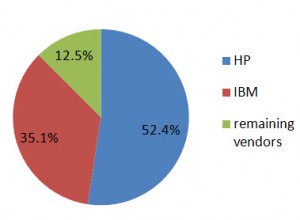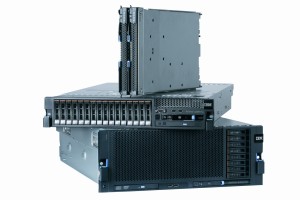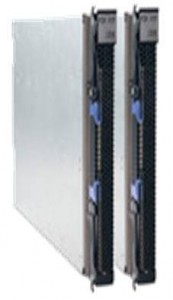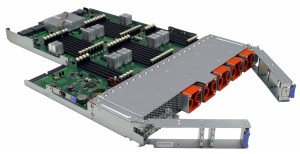NOTE: IDC revised their report on May 28, 2010. This post now includes those changes.
IDC reported on May 28, 2010 that worldwide server sales for Q1 2010 factory revenues increased 4.6 4.7% year over year to $10.4 billion in the first quarter of 2010 (1Q10). They also reported the blade server market accelerated and continued its sharp growth in the quarter with factory revenue increasing 37.1% 37.2% year over year, with shipment growth increasing by 20.8% compared to 1Q09. According to IDC, nearly 90% of all blade revenue is driven by x86 systems, a segment in which blades now represent 18.8% of all x86 server revenue. Continue reading
Tag Archives: IBM
(UPDATED) Prize Fight: IBM MAX5 vs Dell FlexMem Bridge
Updated 5/24/2010 – I’ve received some comments about expandability and I’ve received a correction about the speed of Dell’s memory, so I’ve updated this post. You’ll find the corrections / additions below in GREEN.
Since I’ve received a lot of comments from my post on the Dell FlexMem Bridge technology, I thought I would do an unbiased comparison between Dell’s FlexMem Bridge technology (via the PowerEdge 11G M910 blade server) vs IBM’s MAX5 + HX5 blade server offering. In summary both offerings provide the Intel Xeon 7500 CPU plus the ability to add “extended memory” offering value for virtualization, databases and any other workloads that benefit from large amounts of memory. Continue reading
More Blade Server Rumours
It’s been a while since I’ve posted what rumours I’m hearing, so I thought I’d dig around and see what I can find out. NOTE: this is purely speculation, I have no definitive information from any vendor about any of this information so this may be false info. Read at your own risk. Continue reading
Cisco, IBM and HP Update Blade Portfolio with Westmere Processor
Intel officially announced today the Xeon 5600 processor, code named “Westmere.” Cisco, HP and IBM also announced their blade servers that have the new processor. The Intel Xeon 5600 offers:
- 32nm process technology with 50% more threads and cache
- Improved energy efficiency with support for 1.35V low power memory
There will be 4 core and 6 core offerings. This processor also provide the option of HyperThreading, so you could have up to 8 threads and 12 threads per processor, or 16 and 24 in a dual CPU system. This will be a huge advantage to applications that like multiple threads, like virtualization. Here’s a look at what each vendor has come out with:
Cisco
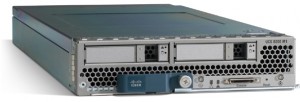 The B200 M2 provides Cisco users with the current Xeon 5600 processors. It looks like Cisco will be offering a choice of the following Xeon 5600 processors: Intel Xeon X5670, X5650, E5640, E5620, L5640, or E5506. Because Cisco’s model is a “built-to-order” design, I can’t really provide any part numbers, but knowing what speeds they have should help.
The B200 M2 provides Cisco users with the current Xeon 5600 processors. It looks like Cisco will be offering a choice of the following Xeon 5600 processors: Intel Xeon X5670, X5650, E5640, E5620, L5640, or E5506. Because Cisco’s model is a “built-to-order” design, I can’t really provide any part numbers, but knowing what speeds they have should help.
HP
HP is starting off with the Intel Xeon 5600 by bumping their existing G6 models to include the Xeon 5600 processor. The look, feel, and options of the blade servers will remain the same – the only difference will be the new processor. According to HP, “the HP ProLiant G6 platform, based on Intel Xeon 5600 processors, includes the HP ProLiant BL280c, BL2x220c, BL460c and BL490c server blades and HP ProLiant WS460c G6 workstation blade for organizations requiring high density and performance in a compact form factor. The latest HP ProLiant G6 platforms will be available worldwide on March 29.” It appears that HP’s waiting until March 29 to provide details on their Westmere blade offerings, so don’t go looking for part numbers or pricing on their website.
IBM
IBM is continuing to stay ahead of the game with details about their product offerings. They’ve refreshed their HS22 and HS22v blade servers:
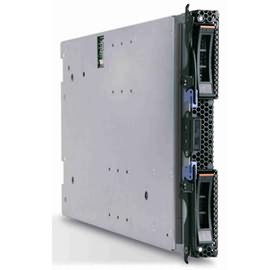 HS22
HS22
7870ECU – Express HS22, 2x Xeon 4C X5560 95W 2.80GHz/1333MHz/8MB L2, 4x2GB, O/Bay 2.5in SAS, SR MR10ie
7870G4U – HS22, Xeon 4C E5640 80W 2.66GHz/1066MHz/12MB, 3x2GB, O/Bay 2.5in SAS
7870GCU – HS22, Xeon 4C E5640 80W 2.66GHz/1066MHz/12MB, 3x2GB, O/Bay 2.5in SAS, Broadcom 10Gb Gen2 2-port
7870H2U -HS22, Xeon 6C X5650 95W 2.66GHz/1333MHz/12MB, 3x2GB, O/Bay 2.5in SAS
7870H4U – HS22, Xeon 6C X5670 95W 2.93GHz/1333MHz/12MB, 3x2GB, O/Bay 2.5in SAS
7870H5U – HS22, Xeon 4C X5667 95W 3.06GHz/1333MHz/12MB, 3x2GB, O/Bay 2.5in SAS
7870HAU – HS22, Xeon 6C X5650 95W 2.66GHz/1333MHz/12MB, 3x2GB, O/Bay 2.5in SAS, Emulex Virtual Fabric Adapter
7870N2U – HS22, Xeon 6C L5640 60W 2.26GHz/1333MHz/12MB, 3x2GB, O/Bay 2.5in SAS
7870EGU – Express HS22, 2x Xeon 4C E5630 80W 2.53GHz/1066MHz/12MB, 6x2GB, O/Bay 2.5in SAS
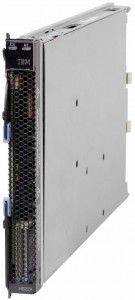 HS22V
HS22V
7871G2U – HS22V, Xeon 4C E5620 80W 2.40GHz/1066MHz/12MB, 3x2GB, O/Bay 1.8in SAS
7871G4U – HS22V, Xeon 4C E5640 80W 2.66GHz/1066MHz/12MB, 3x2GB, O/Bay 1.8in SAS
7871GDU – HS22V, Xeon 4C E5640 80W 2.66GHz/1066MHz/12MB, 3x2GB, O/Bay 1.8in SAS
7871H4U – HS22V, Xeon 6C X5670 95W 2.93GHz/1333MHz/12MB, 3x2GB, O/Bay 1.8in SAS
7871H5U – HS22V, Xeon 4C X5667 95W 3.06GHz/1333MHz/12MB, 3x2GB, O/Bay 1.8in SAS
7871HAU – HS22V, Xeon 6C X5650 95W 2.66GHz/1333MHz/12MB, 3x2GB, O/Bay 1.8in SAS
7871N2U – HS22V, Xeon 6C L5640 60W 2.26GHz/1333MHz/12MB, 3x2GB, O/Bay 1.8in SAS
7871EGU – Express HS22V, 2x Xeon 4C E5640 80W 2.66GHz/1066MHz/12MB, 6x2GB, O/Bay 1.8in SAS
7871EHU – Express HS22V, 2x Xeon 6C X5660 95W 2.80GHz/1333MHz/12MB, 6x4GB, O/Bay 1.8in SAS
I could not find any information on what Dell will be offering, from a blade server perspective, so if you have information (that is not confidential) feel free send it my way.
IDC Q4 2009 Report: Blade Servers STILL Growing, HP Leads STILL Leading in Shares
IDC reported on February 24, 2010 that blade server sales for Q4 2009 returned to quarterly revenue growth with factory revenues increasing 30.9% in Q4 2009 year over year (vs 1.2% in Q3.) For the first time in 2009 there was an 8.3% increase in year-over-year shipments in Q4. Overall blade servers accounted for $1.8 billion in Q4 2009 (up from $1.3 billion in Q3) which represented 13.9% of the overall server revenue. It was also reported that more than 87% of all blade revenue in Q4 2009 was driven by x86 systems where blades now represent 21.4% of all x86 server revenue.
While the press release did not provide details of the market share for all of the top 5 blade vendors, they did provide data for the following:
#1 market share: HP with 52.4%
#2 market share: IBM increased their marketshare from Q3 by 5.7% growth to 35.1%
As an important note, according to IDC, IBM significantly outperformed the market with year-over-year revenue growth of 64.1%.
According to Jed Scaramella, senior research analyst in IDC's Datacenter and Enterprise Server group, "Blades remained a bright spot in the server vendors’ portfolios. They were able to grow blade revenue throughout the year while maintaining their average selling prices. Customers recognize the benefits extend beyond consolidation and density, and are leveraging the platform to deliver a dynamic IT environment. Vendors consider blades strategic to their business due to the strong loyalty customers develop for their blade vendor as well as the higher level of pull-through revenue associated with blades."
Virtual I/O on IBM BladeCenter (IBM Virtual Fabric Adapter by Emulex)
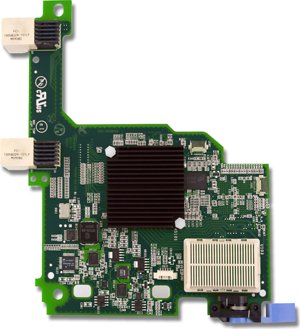 A few weeks ago, IBM and Emulex announced a new blade server adapter for the IBM BladeCenter and IBM System x line, called the “Emulex Virtual Fabric Adapter for IBM BladeCenter" (IBM part # 49Y4235). Frequent readers may recall that I had a "so what" attitude when I blogged about it in October and that was because, I didn't get it. I didn't get what the big deal was with being able to take a 10Gb pipe and allow you to carve it up into 4 "virtual NICs". HP's been doing this for a long time with their FlexNICs (check out VirtualKennth's blog for a great detail on this technology) so I didn't see the value in what IBM and Emulex was trying to do. But now I understand. Before I get into this, let me remind you of what this adapter is. The Emulex Virtual Fabric Adapter (CFFh) for IBM BladeCenter is a dual-port 10 Gb Ethernet card that supports 1 Gbps or 10 Gbps traffic, or up to eight virtual NIC devices.
A few weeks ago, IBM and Emulex announced a new blade server adapter for the IBM BladeCenter and IBM System x line, called the “Emulex Virtual Fabric Adapter for IBM BladeCenter" (IBM part # 49Y4235). Frequent readers may recall that I had a "so what" attitude when I blogged about it in October and that was because, I didn't get it. I didn't get what the big deal was with being able to take a 10Gb pipe and allow you to carve it up into 4 "virtual NICs". HP's been doing this for a long time with their FlexNICs (check out VirtualKennth's blog for a great detail on this technology) so I didn't see the value in what IBM and Emulex was trying to do. But now I understand. Before I get into this, let me remind you of what this adapter is. The Emulex Virtual Fabric Adapter (CFFh) for IBM BladeCenter is a dual-port 10 Gb Ethernet card that supports 1 Gbps or 10 Gbps traffic, or up to eight virtual NIC devices.
This adapter hopes to address three key I/O issues:
1.Need for more than two ports per server, with 6-8 recommended for virtualization
2.Need for more than 1Gb bandwidth, but can't support full 10Gb today
3.Need to prepare for network convergence in the future
"1, 2, 3, 4"
I recently attended an IBM/Emulex partner event and Emulex presented a unique way to understand the value of the Emulex Virtual Fabric Adapter via the term, "1, 2, 3, 4" Let me explain:
"1" – Emulex uses a single chip architecture for these adapters. (As a non-I/O guy, I'm not sure of why this matters – I welcome your comments.)
"2" – Supports two platforms: rack and blade (Easy enough to understand, but this also emphasizes that a majority of the new IBM System x servers announced this week will have the Virtual Fabric Adapter "standard")
"3" – Emulex will have three product models for IBM (one for blade servers, one for the rack servers and one intergrated into the new eX5 servers)
"4" – There are four modes of operation:
-
Legacy 1Gb Ethernet
-
10Gb Ethernet
-
Fibre Channel over Ethernet (FCoE)…via software entitlement ($$)
-
iSCSI Hardware Acceleration…via software entitlement ($$)
This last part is the key to the reason I think this product could be of substantial value. The adapter enables a user to begin with traditional Ethernet, then grow into 10Gb, FCoE or iSCSI without any physical change – all they need to do is buy a license (for the FCoE or iSCSI).
Modes of operation
The expansion card has two modes of operation: standard physical port mode (pNIC) and virtual NIC (vNIC) mode.
In vNIC mode, each physical port appears to the blade server as four virtual NIC with a default bandwidth of 2.5 Gbps per vNIC. Bandwidth for each vNIC can be configured from 100 Mbps to 10 Gbps, up to a maximum of 10 Gb per virtual port.
In pNIC mode, the expansion card can operate as a standard 10 Gbps or 1 Gbps 2-port Ethernet expansion card.
As previously mentioned, a future entitlement purchase will allow for up to two FCoE ports or two iSCSI ports. The FCoE and iSCSI ports can be used in combination with up to six Ethernet ports in vNIC mode, up to a maximum of eight total virtual ports.
Mode IBM Switch Compatibility
vNIC – works with BNT Virtual Fabric Switch
pNIC – works with BNT, IBM Pass-Thru, Cisco Nexus
FCoE– BNT or Cisco Nexus
iSCSI Acceleration – all IBM 10GbE switches
I really think the "one card can do all" concept works really well for the IBM BladeCenter design, and I think we'll start seeing more and more customers move toward this single card concept.
Comparison to HP Flex-10
I'll be the first to admit, I'm not a network or storage guy, so I'm not really qualified to compare this offering to HP's Flex-10, however IBM has created a very clever video that does some comparisons. Take a few minutes to watch and let me know your thoughts.
7 habits of highly effective people
pet food express
cartoon network video
arnold chiari malformation
category 1 hurricane
Announcing IBM eX5 Portfolio and the HX5 Blade Server
IBM’s Enterprise x-Architecture has been around for quite a while providing unique Scalability, Reliability and Flexibility in the x86 4-socket platforms. You can check out the details of the eX4 technology here.
Today’s announcement offered up a few facts:
a) the existing x3850 and x3950 M2 will be called x3850 and x3950 X5 signifying a trend for IBM to move toward product naming designations that reflect the purpose of the server.
b) the x3850 and x3950 X5’s will use the Intel Nehalem EX – to be officially announced/released on March 30. At this time we can expect full details including part numbers, pricing and technical specifications.
e) IBM also announced a new technology, known as “FlexNode” that offers up physical partitioning capability for servers to move from being a single system to 2 different unique systems and back again.
An observation from the pictures of the HX5 is that it will not have hot-swap drives, like the HS22’s do. This means there will be internal drives – most like solid state drives (SSDs). You may recall from my previous rumour post that the lack of hot-swap drives is pretty evident – IBM needed the real estate for the memory. Unfortunately until memristors become available, blade vendors will need to sacrifice real estate for memory.
2) As part of the MAX5 technology, IBM will also be launching a memory blade to increase the overall memory on the HX5 blade server. Expect more details on this in the near future.
Visit IBM’s website for their Live eX5 Event at 2 p.m. Eastern time at this site:
As more information comes out on the new IBM eX5 portfolio, check back here and I’ll keep you posted. I’d love to hear your thoughts in the comments below.
maryland general hospital
horror movies 2010
ny gay marriage
online grocery coupons
smith goggles
Introducing the IBM HS22v Blade Server
IBM officially announced today a new addition to their blade server line – the HS22v. Modeled after the HS22 blade server, the HS22v is touted by IBM as a “high density, high performance blade optimized for virtualization.” So what makes it so great for virtualization? Let’s take a look.
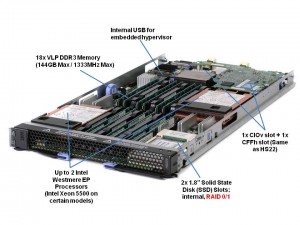 Memory
Memory
One of the big differences between the HS22v and the HS22 is more memory slots. The HS22v comes with 18 x very low profile (VLP) DDR3 memory DIMMs for a maximum of 144GB RAM. This is a key attribute for a server running virtualization since everyone knows that VM’s love memory. It is important to note, though, the memory will only run at 800Mhz when all 18 slots are used. In comparison, if you only had 6 memory DIMMs installed (3 per processor) then the memory would run at 1333Mhz and 12 DIMMs installed (6 per processor) runs at 1066Mhz. As a final note on the memory, this server will be able to use both 1.5v and 1.35v memory. The 1.35v will be newer memory that is introduced as the Intel Westmere EP processor becomes available. The big deal about this is that lower voltage memory = lower overall power requirements.
Drives
The second big difference is the HS22v does not use hot-swap drives like the HS22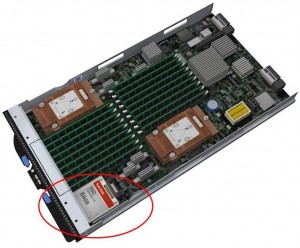 does. Instead, it uses a 2 x solid state drives (SSD) for local storage. These drives have hardware RAID 0/1 capabilities standard. Although the picture to the right shows a 64GB SSD drive, my understanding is that only 50GB drives will be available as they start to become readlily available on March 19, with larger sizes (64GB and 128GB) becoming available in the near future. Another thing to note is that the image shows a single SSD drive, however the 2nd drive is located directly beneath. As mentioned above, these drives do have the ability to be set up in a RAID 0 or 1 as needed.
does. Instead, it uses a 2 x solid state drives (SSD) for local storage. These drives have hardware RAID 0/1 capabilities standard. Although the picture to the right shows a 64GB SSD drive, my understanding is that only 50GB drives will be available as they start to become readlily available on March 19, with larger sizes (64GB and 128GB) becoming available in the near future. Another thing to note is that the image shows a single SSD drive, however the 2nd drive is located directly beneath. As mentioned above, these drives do have the ability to be set up in a RAID 0 or 1 as needed.
So – why did IBM go back to using internal drives? For a few reasons:
Reason #1 : in order to get the space to add the extra memory slots, a change had to be made in the design. IBM decided that solid state drives were the best fit.
Reason #2: the SSD design allows the server to run with lower power. It’s well known that SSD drives run at a much lower power draw than physical spinning disks, so using SSD’s will help the HS22v be a more power efficient blade server than the HS22.
Reason #3: a common trend of virtualization hosts, especially VMware ESXi, is to run on integrated USB devices. By using an integrated USB key for your virtualization software, you can eliminate the need for spinning disks, or even SSD’s therefore reducing your overall cost of the server.
Processors
So here’s the sticky area. IBM will be releasing the HS22v with the Intel Xeon 5500 processor first. Later in March, as the Intel Westmere EP (Intel Xeon 5600) is announced, IBM will have models that come with it. IBM will have both Xeon 5500 and Xeon 5600 processor offerings. Why is this? I think for a couple of reasons:
a) the Xeon 5500 and the Xeon 5600 will use the same chipset (motherboard) so it will be easy for IBM to make one server board, and plop in either the Nehalem EP or the Westmere EP
b) simple – IBM wants to get this product into the marketplace sooner than later.
Questions
1) Will it fit into the BladeCenter E?
YES – however there may be certain limitations, so I’d recommend you reference the IBM BladeCenter Interoperability Guide for details.
2) Is it certified to run VMware ESX 4?
YES
3) Why didn’t IBM call it HS22XM?
According to IBM, the “XM” name is feature focused while “V” is workload focused – a marketing strategy we’ll probably see more of from IBM in the future.
That’s it for now. If there are any questions you have about the HS22v, let me know in the comments and I’ll try to get some answers.
For more on the IBM HS22v, check out IBM’s web site here.
Check back with me in a few weeks when I’m able to give some more info on what’s coming from IBM!
Mark Your Calendar – Upcoming Announcements
As I mentioned previously, the next few weeks are going to be filled with new product / technology annoucements. Here’s a list of some dates that you may want to mark on your calendar (and make sure to come back here for details:)
Feb 9 – Big Blue new product announcement (hint: in the BladeCenter family)
Mar 2 – Big Blue non-product annoucement (hint: it’s not the eX4 family)
Mar 16 – Intel Westmere (Intel Xeon 5600) Processor Announcement (expect HP and IBM to announce their Xeon 5600 offerings)
Mar 30 – Intel Nehalem EX (Xeon 7600) Processor Annoucement (expect HP and IBM to announce their Intel Xeon 7600 offerings)
As always, you can expect for me to give you coverage on the new blade server technology as it gets announced!
More IBM BladeCenter Rumours…
Okay, I can’t hold back any longer – I have more rumours. The next 45 days is going to be an EXTREMELY busy month with Intel announcing their Westmere EP processor, the predecessor to the Nehalem EP CPU and with the announcement of the Nehalem EX CPU, the predecessor to the Xeon 7400 CPU. I’ll post more details on these processors in the future, as it becomes available, but for now, I want to talk on some additional rumours that I’m hearing from IBM. As I’ve mentioned in my previous rumour post: this is purely speculation, I have no definitive information from IBM so this may be false info. That being said, here we go:
Rumour #1: As I previously posted, IBM has announced they will have a blade server based on their eX5 architecture – the next generation of their eX4 architecture found in their IBM System x3850 M2 and x3950M2. I’ve posted what I think this new blade server will look like (you can see it here) and I had previously speculated that the server would be called HS43 – however it appears that IBM may be changing their nomenclature for this class of blade to “HX5“. I can see this happening – it’s a blend of “HS” and “eX5”. It is a new class of blade server, so it makes sense. I like the HX5 blade server name, although if you Google HX5 right now, you’ll get a lot of details about the Sony CyberShot DSC-HX5 digital camera. (Maybe IBM should re-consider using HS43 instead of HX5 to avoid any lawsuits.) It also makes it very clear that it is part of their eX5 architecture, so we’ll see if it gets announced that way.
Speaking of announcements…
Rumour #2: While it is clear that Intel is waiting until March (31, I think) to announce the Nehalem EX and Westmere EP processors, I’m hearing rumours that IBM will be announcing their product offerings around the new Intel processors on March 2, 2010 in Toronto. It will be interesting to see if this happens so soon (4 weeks away) but when it does, I’ll be sure to give you all the details!
That’s all I can talk about for now as “rumours”. I have more information on another IBM announcement that I can not talk about, but come back to my site on Feb. 9 and you’ll find out what that new announcement is.
